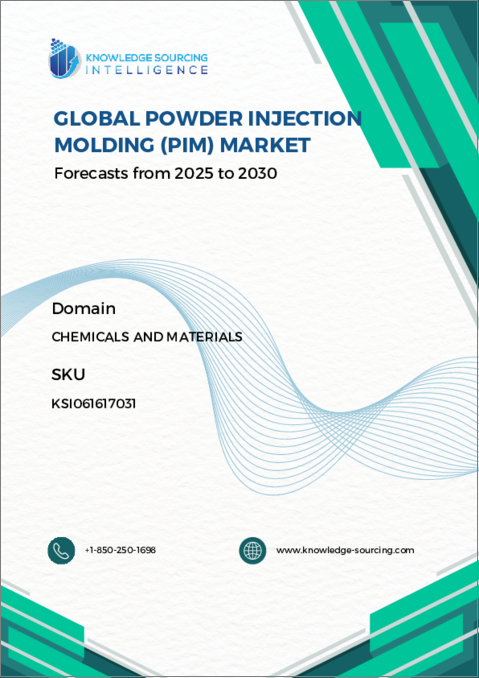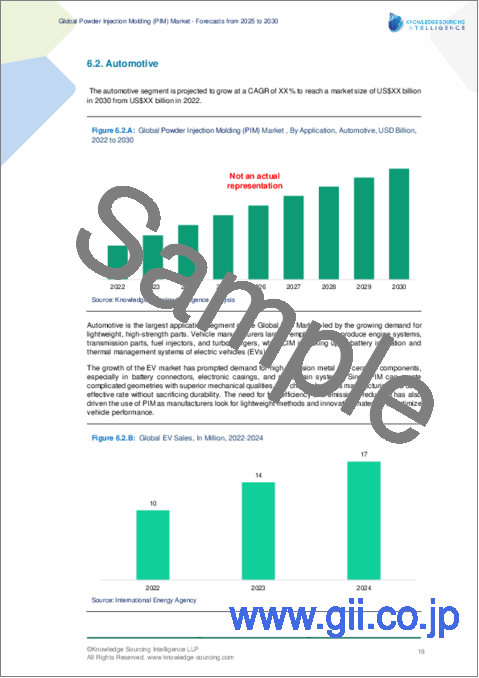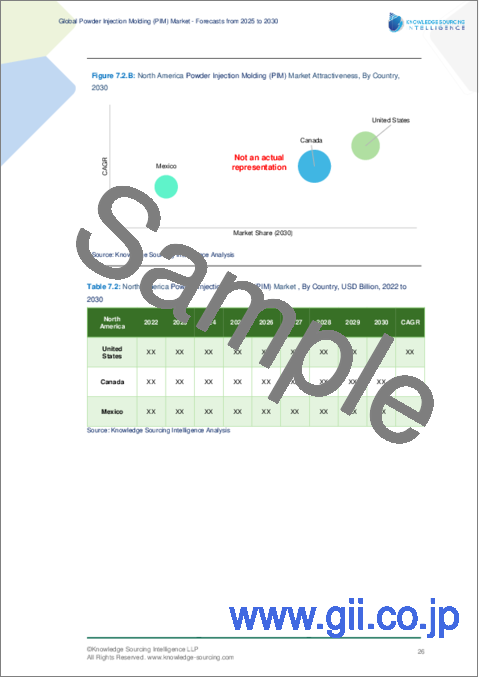|
|
市場調査レポート
商品コード
1532999
粉末射出成形の世界市場 - 2024年~2029年までの予測Global Powder Injection Molding Market - Forecasts from 2024 to 2029 |
||||||
カスタマイズ可能
|
|||||||
| 粉末射出成形の世界市場 - 2024年~2029年までの予測 |
|
出版日: 2024年07月18日
発行: Knowledge Sourcing Intelligence
ページ情報: 英文 140 Pages
納期: 即日から翌営業日
|
全表示
- 概要
- 目次
粉末射出成形市場は、予測期間中(2024年~2029年)にCAGR8.92%で成長すると予測されています。
粉末射出成形(PIM)は、複雑な形状の金属(MIM=金属射出成形)やセラミックス(CIM=セラミック射出成形)からなる部品を大量生産するプロセス技術です。PIMは、複雑で機能的な部品を大量に生産するための優れた技術であり、多くの材料を必要とします。
今日、粉末冶金射出成形は、0.1gから300gの中小型部品を低コストで大量生産する技術であり、精密機器工学、計測・制御技術、医療技術、時計・住宅技術、錠前・建具事業、自動車、兵器産業などがその代表的な用途です。
粉末射出成形の歴史に端を発するPIMは、確立された粉末冶金とセラミック加工技術を基盤としており、メーカーや設計者が多様な素材の可能性から選択できる高い固有の汎用性を持っています。このプロセスは金属やセラミックの粉末から始まるため、強度、導電性、耐食性など、希望する特性を得るためにさまざまな粉末を混合することができるからです。PIMプロセスで使用されるバインダーは、射出成形時に粉末を流動性のある液体にすることができます。このことは、通常では柔軟性がなく、成形が簡単でないものも含め、さまざまな材料をPIMで成形できることを意味します。同時に、こうした数多くの材料オプションは高いレベルの設計柔軟性を提供し、粉末射出成形を多くの分野の変化する需要に合わせてカスタマイズすることを可能にします。
世界の粉末射出成形市場の促進要因:
- 自動車部品は、様々な走行条件下で使用されるため、強靭で耐久性が求められます。これらの要件は、エンジン部品、ギアボックスシステム、その他の構造部品のような複雑な部品の製造にPIM技術を使用することで満たすことができます。PIMは、他の工程に必要な材料とは異なるため、自動車メーカーはコストを削減することができます。PIMの多機能性により、金属、セラミック、ポリマーを自動車用途に使用することが可能です。
さらに、PIMの助けを借りて、ハイミキサーを実現することで、製造業の要求に対応する高品質の部品の大量生産が保証されます。自動車産業の成長は、この利用をさらに促進します。自動車工業会(SMMT)によると、英国の自動車生産台数は2023年に86万台、2028年には100万台に達すると予想されています。
それにもかかわらず、2024年3月、Tata Motors Groupはタミル・ナードゥ州政府と、同州での自動車製造工場設立に関する調査研究に関する円滑化覚書(MoU)を締結しました。この覚書では、5年間で10億8,160万米ドル(900億インドルピー)を投資することになっています。
さらに、粉末射出成形は、設計の自由度、経済的利益、部品性能の向上を自動車技術と性能に導入することで、自動車製造に大きく貢献しています。
- PIMの製品投入は、より高品質の材料、高度な加工メカニズム、新規アプリケーションの開拓によって市場の成長を促進します。これらの進歩により、自動車、航空宇宙、エレクトロニクスなどの分野で重要な、複雑な形状、高性能部品、軽量部品の製造が可能になります。例えば、INDO-MIMは、設計、金型、材料、多くの仕上げと組立手順における専門知識と技術を持つ、完全に統合された金属射出成形(MIM)部品メーカーです。インドと米国に産業基盤を持つINDO-MIMは、世界最大のMIM設備能力を有しています。
これと並行して、バインダーシステムと焼結方法の変更により、PIMをより競争力のあるものへと押し上げ、常に利益を高め、コストを下げています。さらに、設計の最適化と金型の革新により、開発時間が短縮され、カスタマイズの選択肢が増えたことで、企業は新しい業界の状況に適応できるようになりました。OptiMIMは、高度な金属射出成形技術を使用して、細部、密度、体積の厳密性が高い小型精密金属部品を作成します。Asahi-Kaseiが提供するTenac-C FF520は、特別に開発された超高流動性ポリアセタール共重合体で、PIMで実施される触媒脱ボンドに使用されます。総じて、製品の継続的な開発は、PIMの望ましさを高め、世界中の多くの産業で採用されています。
世界の粉末射出成形市場のセグメント分析:
- 技術に基づくと、金属射出成形は最も急速に発展しているセグメントの一つです。
金属射出成形(MIM)は、複雑な形状を大量に作るための製造能力を提供します。この技術では、バインダー(さまざまな熱可塑性プラスチック、ワックス、その他の材料)と共にカスタム調合された極小の金属粉(通常は20マイクロメートル未満)を使用して原料を形成します。原料は、標準的な射出成形機のキャビティ(または多数のキャビティ)に導入されます。グリーンコンポーネントを取り出した後、バインダーの大部分は熱処理または溶剤処理によって抽出され、残りは除去されます。対照的に、コンポーネントは制御された雰囲気炉で焼結(固体分散)されます。MIM法はプラスチック射出成形や高圧ダイカストと極めて類似しており、ほぼ同じ形状や構成特性を生み出すことができます。
金属射出成形法は、寸法公差制御に優れたネットシェイプ加工技術でありながら、溶製材とほぼ同じ機械的品質を生み出します。金属射出成形部品は、実質的に無限の形状および幾何学的特徴能力を有し、マルチキャビティ金型を使用することにより、大きな生産速度を達成することができます。
特に自動車分野では、高精度で優れた機械的特性を持つ小型の繊細な金属部品を製造できることから、MIMが採用されています。MIMは、ギヤ、ヒンジ、ブラケット、さまざまなエンジンやギアボックス部品などの部品に、ネットシェイプに近い加工を可能にすることで利益をもたらし、その後の処置の必要性や材料の無駄を減らします。例えば、Invest Indiaの統計によると、2023年4月から2024年3月にかけて、インドでは自動車産業が2,843万台の自動車を製造しており、これには乗用車、商用車、三輪車、二輪車、四輪車が含まれます。
- アジア太平洋の粉末射出成形市場は大きく成長すると予想されます。
アジア太平洋の粉末射出成形(PIM)市場は、特に中国、日本、インド、韓国といった自動車・電子機器製造の主要拠点における工業化の進展に後押しされています。金属射出成形のようなPIM技術は、軽量で高性能な部品を求めるこれらの産業の特徴です。Invest Indiaによると、2023年、インドのエレクトロニクス市場は約1,550億米ドルで、現地メーカーは1,007億5,000万米ドル(65%)を占めています。さらに、上海市人民政府のデータによると、2023年の中国のコンシューマーエレクトロニクスの小売売上高は3,050億米ドルで、成長率は4%でした。2024年には5%に上昇します。
さらに、2023年にPIBが述べたように、過去20年間で、インドの自動車産業はまったく新しいレベルにまで進歩し、世界的に最も競争力のある産業の1つとして認識されています。二輪車の生産では世界第2位、商用車では世界第8位、乗用車では世界第6位、トラクターの生産では世界第1位となっています。近年、インドは自動車部品や自動車の生産地として好んで選ばれる国のひとつに浮上し、競争力のある場所として順位を上げています。一方、Hyundai Motorsは2024年2月、EVポートフォリオを拡充し、現在の自動車とSUVのプラットフォームを改善するため、2023年から2033年の間に38億5,000万米ドル(3,200億インドルピー)以上を投資すると発表しました。
このほか、中国は年間販売台数、生産台数ともに世界最大の自動車市場であり、現地生産台数は2025年までに3,500万台を超えると予測されています。工業情報化省の数字によると、2021年の自動車販売台数は2,600万台を超え、うち乗用車は2020年比7.1%増の2,148万台となっています。
この動向は、世界のPIM市場においてアジア太平洋が極めて重要な位置を占めていることを浮き彫りにしています。アジア太平洋は、技術開拓と様々な産業分野にわたるアプリケーションの増加に押されています。例えば、2021年7月、BASFは中国の上海にCatamold事業の新しいCentre of Excellence の研究所を設立しました。この新工場は、中国およびアジア全域におけるMIMソリューションと製品に関する知識の拠点となります。
粉末射出成形市場の主要な発展:
- 2024年1月、AddUpのTooling Competence Centreは、射出成形用途の付加製造の進歩を開発・実施する新プロジェクト「#2024AMIM-2024 Additive Manufacturing for Injection Moulding」を発表しました。
- 2023年11月、HP Inc.は、世界有数の付加製造イベントであるFormnextにおいて、MIM業界の世界最大手の1つであり、付加製造パウダー業界の新興プレーヤーであるINDO-MIMとの戦略的パートナーシップを発表しました。INDO-MIMはもともと、この協力の一環として3台の最新鋭HP Metal Jet S100プリンターに投資しており、付加製造の国際的な改善への献身を示しています。
- 2022年12月、CoreTech System Co., Ltd.(Moldex3D)は、Sumitomo Heavy Industries, Ltd.(SHI)との戦略的提携を発表し、バーチャルCAEシミュレーションと実用的な射出成形機の統合を改善しました。この提携により、CAEシミュレーションと実際の射出成形機をつなぐ双方向の橋渡しが確立されました。
粉末射出成形市場は以下のようにセグメント化され、分析されています:
タイプ別
- 金属射出成形(MIM)
- セラミック射出成形(CIM)
用途別
- 自動車
- 航空宇宙
- 電気・電子
- 医療
- その他
地域別
- 北米
- 米国
- カナダ
- メキシコ
- 南米
- ブラジル
- アルゼンチン
- その他南米
- 欧州
- 英国
- ドイツ
- フランス
- イタリア
- スペイン
- その他欧州
- 中東・アフリカ
- サウジアラビア
- アラブ首長国連邦
- その他中東・アフリカ
- アジア太平洋地域
- 中国
- インド
- 日本
- 韓国
- 台湾
- タイ
- インドネシア
- その他アジア太平洋
目次
第1章 イントロダクション
- 市場概要
- 市場の定義
- 調査範囲
- 市場セグメンテーション
- 通貨
- 前提条件
- 基準年と予測年のタイムライン
- 利害利害関係者にとっての主要なメリット
第2章 調査手法
- 調査デザイン
- 調査プロセス
第3章 エグゼクティブサマリー
- 主要な調査結果
- アナリストビュー
第4章 市場力学
- 市場促進要因
- 自動車産業における需要の高まり
- テクノロジーの進歩
- 市場抑制要因
- 初期投資額が高い
- 代替品の入手可能性
- ポーターのファイブフォース分析
- 業界バリューチェーン分析
第5章 粉末射出成形の世界市場:タイプ別
- イントロダクション
- 金属射出成形(MIM)
- セラミック射出成形(CIM)
第6章 粉末射出成形の世界市場:用途別
- イントロダクション
- 自動車
- 航空宇宙
- 電気・電子
- 医学
- その他
第7章 粉末射出成形の世界市場:地域別
- 世界概要
- 北米
- 米国
- カナダ
- メキシコ
- 南米
- ブラジル
- アルゼンチン
- その他南米
- 欧州
- 英国
- ドイツ
- フランス
- イタリア
- スペイン
- その他欧州地域
- 中東・アフリカ
- サウジアラビア
- アラブ首長国連邦
- その他中東・アフリカ
- アジア太平洋
- 中国
- インド
- 日本
- 韓国
- 台湾
- タイ
- インドネシア
- その他アジア太平洋
第8章 競合環境と分析
- 主要企業と戦略分析
- 市場シェア分析
- 合併、買収、合意、コラボレーション
- 競合ダッシュボード
第9章 企業プロファイル
- Arburg GmbH
- Arc Group Worldwide
- GKN Powder Metallurgy
- INDO-MIM
- Metal Powder Products
- Schunk Group
- Morgan Technical Ceramics
- Epson Atmix Corporation
- ASH Industries
- Philips Medisize
- ATW Companies
- Honganas
- Optimim
- Redstone Manufacturing
- Plansee SE
The global powder injection molding market is anticipated to grow at a CAGR of 8.92% during the forecast period (2024-2029).
Powder Injection Molding (PIM) is a mass-production process technique that produces components composed of metal (MIM = Metal Injection Moulding) or ceramics (CIM = Ceramic Injection Moulding) with complicated geometries in a high output. PIM is a great technique for producing complicated, functioning components in large quantities with high material needs.
Today, metallurgical powder injection molding is a low-cost mass manufacturing technology for producing small to medium-sized components weighing between 0.1 and 300 g. Precision apparatus engineering, measurement and control technology, medical technology, watch and home technologies, the lock and fittings business, automobile, and the weapons industry are among the most common applications.
PIM, which originates in the history of powder injection molding, is based on established powder metallurgy and ceramic processing technologies, and it has a high inherent versatility, allowing manufacturers and designers to choose from a wide variety of material possibilities. This is because the process starts with a metal or ceramic powder; therefore, various powders can be mixed to get the desired properties, such as strength, electrical conductivity, or corrosion resistance. The binder used in the PIM process allows the powder to be a fluidized liquid during injection molding. This implies that various materials may be molded with PIM, including those that are not normally pliable or simple to form. At the same time, these numerous material options provide a high level of design flexibility, allowing powder injection molding to be customized to the changing demands of many sectors.
GLOBAL POWDER INJECTION MOLDING MARKET DRIVERS:
- Automotive parts have to be tough and enduring due to the several driving conditions they operate. These requirements can be satisfied by using PIM technology to build complex components like engine parts, gearbox systems, and other structural parts. PIM enables car manufacturers to reduce costs because it differs from the materials needed for other processes. Due to the multifunctionality of PIM, it is possible to use metals, ceramics, and polymers for automotive applications.
Furthermore, with the help of PIM, the actualization of high mixers ensures high-volume production of high-quality components, which corresponds to the requirements of the manufacturing industry. The growth in the automotive industry further fuels this utilization. According to the Society of Motor Manufacturers and Traders (SMMT), the United Kingdom's output is anticipated to hit 860,000 automobiles in 2023 and a million by 2028.
Nonetheless, in March 2024, Tata Motors Group entered into a facilitation Memorandum of Understanding (MoU) with the Tamil Nadu government regarding an exploratory study on setting up a car manufacturing plant in the state. The MoU calls for an investment of US$1,081.6 million (Rs. 9,000 crores) over five years.
Moreover, powder injection molding persistently contributes to automotive manufacturing by introducing design freedom, economic benefits, and enhanced component performance to vehicle technology and performance to a significantly large extent.
- Product launches in PIM drive the market's growth by developing better quality materials, advanced mechanisms of processing, and novel applications. These advancements enable the manufacturing of complicated geometries, high-performance components, and lightweight parts crucial for sectors such as automotive, aerospace, and electronics. INDO-MIM, for instance, is a fully integrated Metal Injection Moulding (MIM) components manufacturer with expertise and skills in design, tooling, materials, and numerous finishing and assembly procedures. With an Industrial basis in India and the USA, INDO-MIM has the largest MIM installed capacity worldwide.
Alongside this, there is a constantly enhanced benefit and lower cost due to changes in binder systems and sintering methods, pushing PIM towards more competitiveness. In addition, design optimization and tooling innovations have reduced development time and increased customization options that enable businesses to adapt to new industry conditions. OptiMIM uses advanced metal injection molding technology to create small precision metal parts with high detail, density, and volume severity. Tenac-C FF520, offered by Asahi-Kasei, is a specially developed ultra-high fluidity polyacetal copolymer used in catalytic debonding carried out in PIM. Altogether, the continuous development of products enhances PIM's desirability and adoption across numerous industries globally.
GLOBAL POWDER INJECTION MOLDING MARKET SEGMENT ANALYSIS:
- Based on technology, metal injection molding is one of the most rapidly developing segments.
Metal injection molding (MIM) provides a manufacturing capacity for making complicated forms in high volumes. The technique uses tiny metal powders (usually less than 20 micrometers) custom-formulated with a binder (different thermoplastics, waxes, and other materials) to form a feedstock. The feedstock is introduced into a cavity (or many cavities) of a standard injection molding machine. After the green component is removed, most of the binder is extracted using thermal or solvent processing, with the remainder removed. In contrast, the component is sintered (solid-state dispersed) in a controlled atmosphere furnace. The MIM method is extremely similar to plastic injection molding and high-pressure die casting, and it can generate almost identical forms and configuration characteristics.
The metal injection molding method produces mechanical qualities almost identical to those of wrought materials while being a net-shape process technology with excellent dimensional tolerance control. Metal injection-molded components have practically limitless form and geometric feature capabilities, and large production rates may be achieved by using multi-cavity tooling.
The automobile sector, in particular, has embraced MIM due to its ability to make small, delicate metal components with high accuracy and outstanding mechanical characteristics. MIM benefits components such as gears, hinges, brackets, and different engine and gearbox parts by allowing for near-net-shape fabrication, which reduces the need for subsequent procedures and material waste. For instance, from April 2023 to March 2024, the automobile industry manufactured 28.43 million cars in India, which included passenger vehicles, commercial vehicles, three-wheelers, two-wheelers, and quadricycles, as per Invest India statistics.
- Asia Pacific's powder injection molding market is anticipated to grow significantly.
The Asia Pacific powder injection molding (PIM) market is being pushed by rising industrialization, notably in China, Japan, India, and South Korea, which are key automotive and electronics manufacturing hubs. PIM technologies like metal injection molding are characteristic of these industries since they seek lightweight and high-performance parts. According to Invest India, in 2023, the electronics market in India was approximately $155 billion, with local manufacturers standing at $100.75 billion, which is 65%. Moreover, according to data from the Shanghai Municipal People's Government, the retail sales of China's consumer electronics were at US$305 billion in 2023, with a 4% growth rate. In 2024, the rate rose to 5%.
Furthermore, as stated by PIB in 2023, during the past 20 years, the Indian automotive industry has advanced to a whole new level, and it is recognized as one of the most competitive globally. It stands in second position in the global production of two-wheelers, eighth position in commercial vehicles, sixth position in passenger vehicles, and for tractor productions, it is in the number one position. In recent years, India has emerged as one of the preferred destinations for automobile parts and automobiles and has climbed up the ladder in competitive locations. On the other hand, Hyundai Motors announced in February 2024 that it will invest more than $3.85 billion (Rs 32,000 crore) between 2023 and 2033 to extend its EV portfolio and improve its current vehicle and SUV platforms.
Besides this, China is the world's largest automobile market in terms of yearly sales and manufacturing output, with local production projected to exceed 35 million vehicles by 2025. According to figures from the Ministry of Industry and Information Technology, more than 26 million automobiles were sold in 2021, including 21.48 million passenger vehicles, a 7.1% increase over 2020.
This trend highlights Asia Pacific's crucial position in the global PIM market, which is being pushed by technical developments and increased applications across various industrial areas. For instance, in July 2021, BASF established a new Centre of Excellence laboratory for its Catamold business in Shanghai, China. The new plant is a hub of knowledge for MIM solutions and products in China and throughout Asia.
Global Powder Injection Molding Market Key Developments:
- In January 2024, AddUp's Tooling Competence Centre announced #2024AMIM - 2024 Additive Manufacturing for Injection Moulding, a new project to develop and implement additive manufacturing advances for injection molding applications.
- In November 2023, At Formnext, the world's leading additive manufacturing event, HP Inc. announced a strategic partnership with INDO-MIM, one of the world's largest players in the MIM industry and an emerging player in the additive manufacturing powder industry. INDO-MIM has originally invested in three cutting-edge HP Metal Jet S100 printers as part of this cooperation, demonstrating its dedication to improving additive manufacturing internationally.
- In December 2022, CoreTech System Co., Ltd. (Moldex3D) announced a strategic relationship with Sumitomo Heavy Industries, Ltd. (SHI) to improve the integration of virtual CAE simulation and practical injection molding machinery. This collaboration established a two-way bridge that connects the CAE simulation to an actual injection molding machine.
The global powder injection molding market is segmented and analyzed as follows:
By Type
- Metal Injection Molding (MIM)
- Ceramics Injection Molding (CIM)
By Application
- Automotive
- Aerospace
- Electrical and Electronics
- Medical
- Others
By Geography
- North America
- United States
- Canada
- Mexico
- South America
- Brazil
- Argentina
- Rest of South America
- Europe
- United Kingdom
- Germany
- France
- Italy
- Spain
- Rest of Europe
- Middle East and Africa
- Saudi Arabia
- United Arab Emirates
- Rest of the Middle East and Africa
- Asia-Pacific
- China
- India
- Japan
- South Korea
- Taiwan
- Thailand
- Indonesia
- Rest of Asia-Pacific
TABLE OF CONTENTS
1. INTRODUCTION
- 1.1. Market Overview
- 1.2. Market Definition
- 1.3. Scope of the Study
- 1.4. Market Segmentation
- 1.5. Currency
- 1.6. Assumptions
- 1.7. Base and Forecast Years Timeline
- 1.8. Key benefits for the stakeholders
2. RESEARCH METHODOLOGY
- 2.1. Research Design
- 2.2. Research Process
3. EXECUTIVE SUMMARY
- 3.1. Key Findings
- 3.2. Analyst View
4. MARKET DYNAMICS
- 4.1. Market Drivers
- 4.1.1. Growing Demand in the Automotive Industry
- 4.1.2. Advancements in Technology
- 4.2. Market Restraints
- 4.2.1. High Initial Investment
- 4.2.2. Availability of Substitutes
- 4.3. Porter's Five Forces Analysis
- 4.3.1. Bargaining Power of Suppliers
- 4.3.2. Bargaining Power of Buyers
- 4.3.3. The Threat of New Entrants
- 4.3.4. Threat of Substitutes
- 4.3.5. Competitive Rivalry in the Industry
- 4.4. Industry Value Chain Analysis
5. GLOBAL POWDER INJECTION MOLDING MARKET BY TYPE
- 5.1. Introduction
- 5.2. Metal Injection Molding (MIM)
- 5.3. Ceramics Injection Molding (CIM)
6. GLOBAL POWDER INJECTION MOLDING MARKET BY APPLICATION
- 6.1. Introduction
- 6.2. Automotive
- 6.3. Aerospace
- 6.4. Electrical and Electronics
- 6.5. Medical
- 6.6. Others
7. GLOBAL POWDER INJECTION MOLDING MARKET BY GEOGRAPHY
- 7.1. Global Overview
- 7.2. North America
- 7.2.1. United States
- 7.2.2. Canada
- 7.2.3. Mexico
- 7.3. South America
- 7.3.1. Brazil
- 7.3.2. Argentina
- 7.3.3. Rest of South America
- 7.4. Europe
- 7.4.1. United Kingdom
- 7.4.2. Germany
- 7.4.3. France
- 7.4.4. Italy
- 7.4.5. Spain
- 7.4.6. Rest of Europe
- 7.5. Middle East and Africa
- 7.5.1. Saudi Arabia
- 7.5.2. United Arab Emirates
- 7.5.3. Rest of the Middle East and Africa
- 7.6. Asia-Pacific
- 7.6.1. China
- 7.6.2. India
- 7.6.3. Japan
- 7.6.4. South Korea
- 7.6.5. Taiwan
- 7.6.6. Thailand
- 7.6.7. Indonesia
- 7.6.8. Rest of Asia-Pacific
8. COMPETITIVE ENVIRONMENT AND ANALYSIS
- 8.1. Major Players and Strategy Analysis
- 8.2. Market Share Analysis
- 8.3. Mergers, Acquisitions, Agreements, and Collaborations
- 8.4. Competitive Dashboard
9. COMPANY PROFILES
- 9.1. Arburg GmbH
- 9.2. Arc Group Worldwide
- 9.3. GKN Powder Metallurgy
- 9.4. INDO-MIM
- 9.5. Metal Powder Products
- 9.6. Schunk Group
- 9.7. Morgan Technical Ceramics
- 9.8. Epson Atmix Corporation
- 9.9. ASH Industries
- 9.10. Philips Medisize
- 9.11. ATW Companies
- 9.12. Honganas
- 9.13. Optimim
- 9.14. Redstone Manufacturing
- 9.15. Plansee SE





